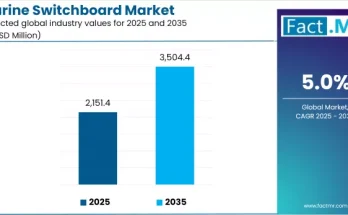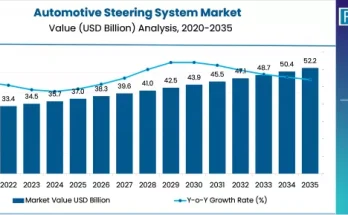The dry van container market is witnessing significant growth as global trade, e-commerce, and logistics networks expand rapidly. Dry van containers, which are enclosed, weather-resistant shipping units, play a critical role in transporting goods across international and domestic supply chains. Their versatility, durability, and ability to protect cargo from environmental conditions make them a cornerstone of modern logistics operations.
With increasing demand for efficient cargo movement, improved supply chain reliability, and cost-effective transportation solutions, dry van containers have become indispensable for shipping companies, freight forwarders, and retailers. Innovations in materials, design, and operational efficiency are further enhancing their role in global trade.
Market Overview
Dry van containers are standardized shipping units designed for the safe transport of non-perishable goods. They are enclosed on all sides, protecting cargo from external elements such as rain, dust, and temperature fluctuations. The standardization of these containers allows them to be easily handled across multiple modes of transport, including ships, trucks, and trains.
Key features of dry van containers include:
- Rigid and durable structural design
- Compatibility with intermodal transportation systems
- Ease of loading, unloading, and stacking
- Weatherproof construction to ensure cargo integrity
- Various size options to meet different shipment requirements
The increasing emphasis on supply chain efficiency, just-in-time delivery models, and e-commerce fulfillment has reinforced the need for reliable dry van containers. Manufacturers are focusing on lightweight materials, corrosion-resistant coatings, and modular designs to improve durability while reducing operational costs.
Regional Insights
North America
North America remains a prominent market for dry van containers due to the region’s extensive logistics network and strong retail and e-commerce sectors. The need for fast, secure, and standardized cargo movement across highways, railways, and ports drives the adoption of high-quality dry van containers. Additionally, rising demand for intermodal transportation solutions supports market expansion.
Europe
Europe’s focus on trade efficiency, sustainability, and technological integration makes it a key market for dry van containers. The region’s dense transportation infrastructure and stringent regulatory standards ensure the widespread use of reliable, standardized shipping units. Manufacturers are also exploring eco-friendly materials and designs to comply with environmental directives.
Asia-Pacific
Asia-Pacific represents one of the fastest-growing markets for dry van containers, driven by booming trade, manufacturing hubs, and expanding e-commerce operations. Countries like China, India, and Southeast Asian nations are investing heavily in logistics infrastructure, supporting container adoption. The growth of regional trade agreements and port modernization initiatives further reinforces demand.
Middle East & Africa
In the Middle East & Africa, growing trade activities, port expansions, and industrial development contribute to steady demand for dry van containers. The region benefits from strategic geographic positioning, facilitating intercontinental shipping and enabling logistics companies to optimize freight movement across multiple sectors.
Key Trends & Forecast
Shift Toward Lightweight and Durable Materials
Manufacturers are increasingly adopting lightweight, corrosion-resistant materials such as aluminum alloys and advanced steel. These innovations improve container longevity, reduce maintenance costs, and enhance fuel efficiency in transportation.
Integration of Tracking and IoT Technologies
Smart dry van containers equipped with GPS tracking, temperature sensors, and IoT-based monitoring systems are becoming more common. These solutions enable real-time visibility, cargo security, and predictive maintenance, enhancing overall supply chain efficiency.
Growing E-commerce and Retail Demand
The rise of e-commerce and retail fulfillment centers has increased the need for versatile, reliable container solutions. Dry van containers facilitate the fast and secure movement of goods between manufacturers, distribution centers, and end consumers.
Focus on Sustainability and Green Logistics
Sustainability initiatives are driving the adoption of eco-friendly containers made from recyclable materials and featuring low-emission coatings. Logistics providers are increasingly looking for solutions that reduce carbon footprints while maintaining cargo safety.
Expansion of Intermodal Transportation
Dry van containers are designed for seamless use across ships, trucks, and trains. The growing adoption of intermodal freight solutions supports the market by enabling efficient cargo transfers without unpacking, reducing handling time and logistics costs.
Applications & End-Use Outlook
Freight and Logistics
The logistics sector is the primary end-user of dry van containers. They are used for transporting general cargo, packaged goods, and retail products over long distances while maintaining product integrity and minimizing damage.
E-commerce and Retail
Retailers and e-commerce companies rely on dry van containers for consistent supply chain operations. Containers help in meeting delivery deadlines, managing inventory flow, and handling high volumes of packaged consumer goods.
Manufacturing and Industrial Goods
Manufacturers use dry van containers to transport raw materials, components, and finished products. Their ability to secure cargo and adapt to various sizes makes them suitable for industrial and production logistics.
Food and Beverage Industry
Although dry van containers are non-refrigerated, they are commonly used to transport packaged and processed food items. Protection from environmental elements ensures product quality during transit.
Automotive and Machinery Components
Dry van containers are utilized to move automotive parts, machinery components, and other durable goods. Their standardized design facilitates easy stacking and handling, improving operational efficiency in industrial supply chains.
Conclusion
The dry van container market is evolving as global trade, e-commerce, and industrial logistics continue to expand. These containers are critical to efficient supply chain operations, providing safe, standardized, and versatile transportation solutions. With ongoing innovations in material technology, IoT integration, and sustainable design, dry van containers are becoming more efficient, durable, and adaptable.
As industries focus on supply chain optimization, sustainability, and secure cargo movement, the demand for high-quality dry van containers will continue to grow. Manufacturers that prioritize innovation, smart technology integration, and eco-friendly design will play a pivotal role in shaping the future of global logistics.
Browse Full Report – https://www.factmr.com/report/1015/dry-van-container-market



